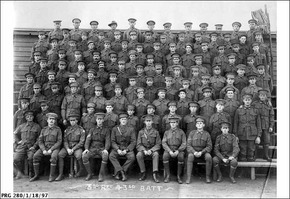
31589
RUSSELL, Alfred
| Service Number: | 161 |
|---|---|
| Enlisted: | 31 August 1915, Date he enlisted |
| Last Rank: | Private |
| Last Unit: | 43rd Infantry Battalion |
| Born: | Aldinga, South Australia, 22 August 1864 |
| Home Town: | Willunga, Onkaparinga, South Australia |
| Schooling: | Not yet discovered |
| Occupation: | Labourer |
| Died: | Norwood, South Australia , 26 June 1942, aged 77 years, cause of death not yet discovered |
| Cemetery: | Not yet discovered |
| Memorials: |
World War 1 Service
| 31 Aug 1915: | Enlisted AIF WW1, Private, 161, 43rd Infantry Battalion, Date he enlisted | |
|---|---|---|
| 9 Jun 1916: | Involvement Private, 161, 43rd Infantry Battalion, --- :embarkation_roll: roll_number: '18' embarkation_place: Adelaide embarkation_ship: HMAT Afric embarkation_ship_number: A19 public_note: '' | |
| 9 Jun 1916: | Embarked Private, 161, 43rd Infantry Battalion, HMAT Afric, Adelaide | |
| 13 Feb 1917: | Wounded AIF WW1, Private, 161, 43rd Infantry Battalion, Wounded on cooking duty (not due to misconduct). | |
| 25 Jun 1917: | Discharged AIF WW1, 161, 43rd Infantry Battalion, Was discharged from duty and sent back to Australia |
Help us honour Alfred Russell's service by contributing information, stories, and images so that they can be preserved for future generations.
Add my storyBiography contributed by St Ignatius' College
Alfred Russel was a 45-year-old man from Willunga, South Australia who signed up for the army on the 31 August 1915. Alfred, on the day of enlistment, had a height of 5 feet and 4 inches, a weight of 126 lbs or 57 kilograms and a chest measurement of 32.5 to 34.5 inches or 82.55 to 87.63 centimetres. Alfred had a fair complexion and had blue eyes and hair which at the time was turning grey. Alfred may have joined for the same reasons any other soldier joined, for the opportunity to travel to other countries and see the world.
After Alfred enlisted and had his health check, he left Australia to go to Europe. Alfred travelled to Egypt along with many more Australian battalions and soldiers to train before fighting at the Western Front. Alfred rode horses across the harsh desert and trained with a rifle to prepare himself for the war. Alfred and his battalion travelled to Britain after to receive further training before heading to the Western Front.
During the start of the year in 1917, Alfred travelled to Flanders in Belgium where he began his first battle. The 43rd battalion fought in Flanders for about 4-5 months, which during this time, consisted of long trench warfare. Trench warfare mainly consisted of long trenches, dug by the soldiers to provide cover for them while they were fighting the enemy.
Unfortunately, Alfred’s service on the western front did not last long. In February 1917 Alfred badly burnt his foot while cooking for the soldiers. Alfred’s scald, just like many other burns, was too painful to continue fighting with, especially if it’s on the foot because that effects his ability to move quickly and be agile. There was also the other risk of infection which could kill you in a number of days as well as make you experience other side effects like fever.
Alfred was quickly moved to the most accessible and closest hospital which was the 14th General Hospital in Wimereux, France. Alfred stayed in this hospital for many days just as other injured and sick soldiers did. After about 4-5 days, Alfred proceeded to England where he reached another hospital called the 23rd Royal Victoria hospital in Netley. Alfred waited in Netley for several months for reasons which is assumed to be to let his foot heal and rest. Alfred was declared disabled during this time and so was discharged for duty as his foot could not heal to its original state. After this came another transfer to the 3rd Aux. Hospital in Dartford England on the 12th of June where he waited for several days before travelling to Weymouth in Southern England. On the 22nd of July, Alfred was sent home (Australia) by one of the few hospital ships called the H.M.H.S St David.
Alfred reached home in a few months but certainly not with a smile on his face. As well as being disabled, Alfred developed chronic dyspepsia upon his voyage. It is assumed that Alfred received this disease either from the conditions he was living in during the war, his diet or it may have been a side effect of being sea sick.










